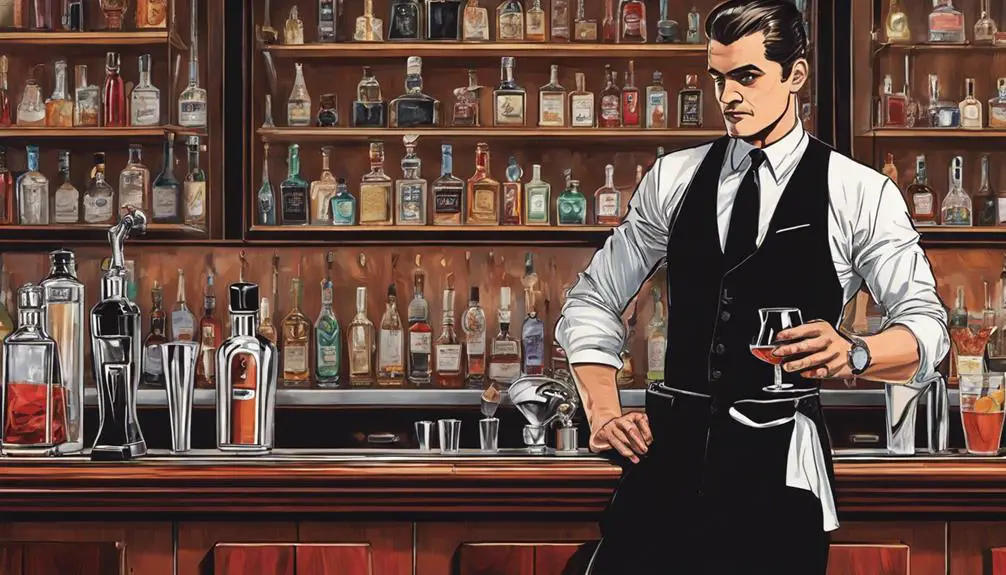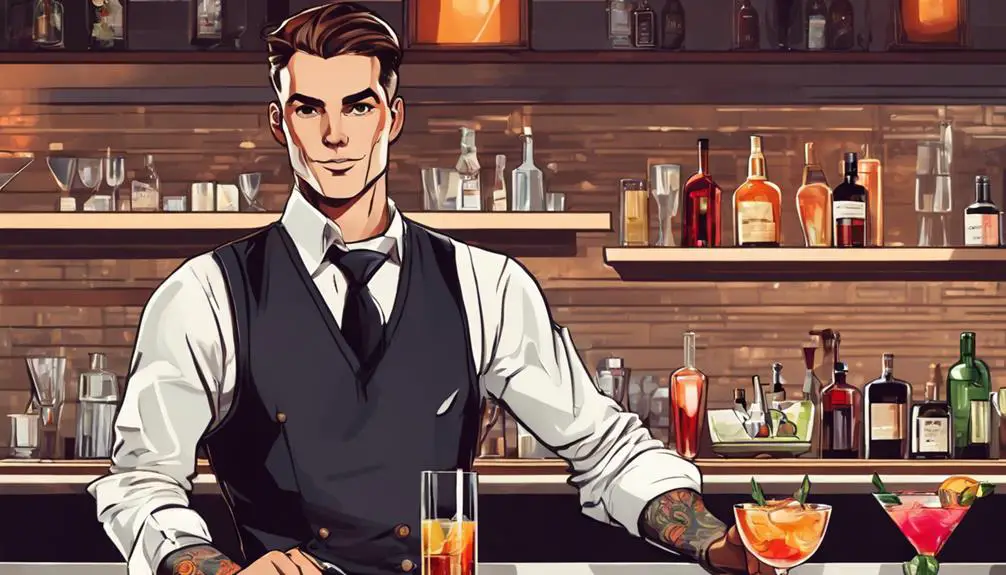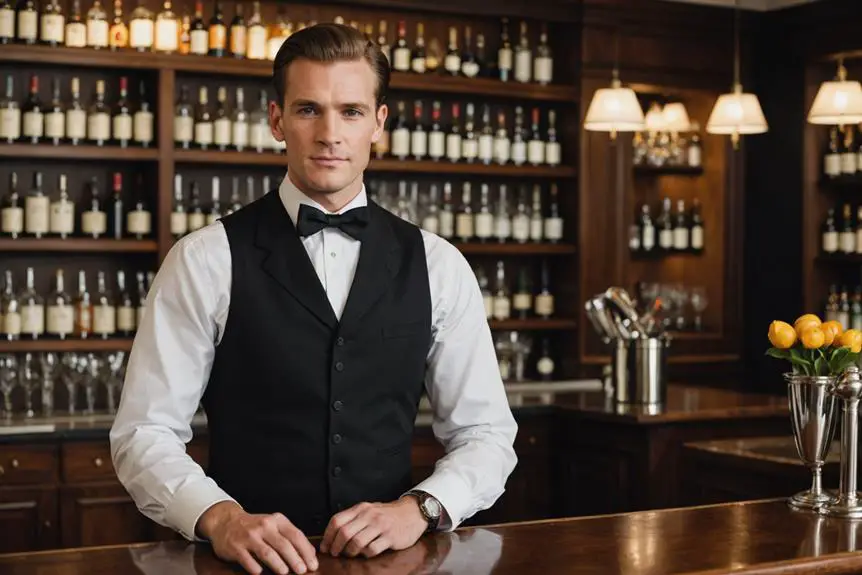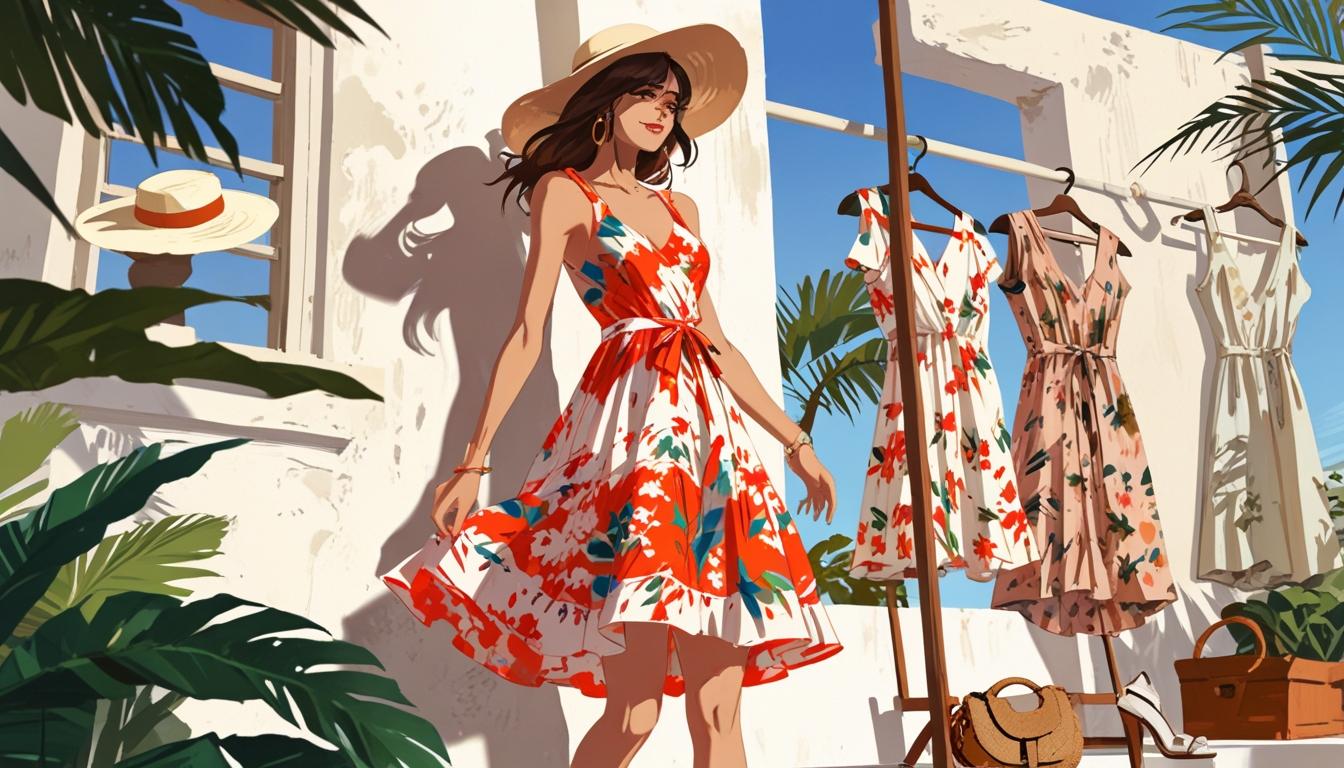To dress as a bartender, you'll want to blend style with comfort and professionalism. Start with a crisp white or black dress shirt paired with tailored black trousers. Dark colors help hide stains, while breathable fabrics keep you comfortable during busy shifts. Non-slip shoes are a must for safety on wet floors. Keep accessories minimal for practicality, but consider an apron for tools. Maintain good grooming and hygiene, as it reflects professionalism. Finally, adapt your outfit to the venue's vibe, whether it's casual or formal. There's more to explore about how attire can enhance your bartending experience.
Bartender Attire Overview

When it comes to bartender attire, you'll want to prioritize both professionalism and practicality. A well-thought-out outfit not only showcases your professional appearance but also guarantees you can work efficiently in a bustling environment. Typically, bartenders opt for dark colors like black, navy blue, or dark green. These shades are not only stylish but also practical, as they conceal stains that can easily occur during busy shifts.
Comfort is key, so investing in durable, breathable materials is essential. You'll be on your feet for long hours, so comfortable shoes, specifically non-slip options, are a must. These shoes provide the necessary grip to prevent slips on wet surfaces, assuring your safety while you hustle behind the bar.
Flexibility in outfit combinations allows you to express your personal style while adhering to the venue's dress code. You can mix and match various pieces to fit both the ambiance of your workplace and your unique flair. For example, pairing a classic black long-sleeved top with tailored trousers can create a polished look while still offering ease of movement.
Keep accessories minimal for safety and practicality—too many items can become a hazard in a fast-paced setting. To summarize, focus on comfortable, professional attire that combines style with functionality, allowing you to shine in your role while guaranteeing you're ready to tackle whatever the shift throws your way!
Essential Clothing Items
A well-rounded bartender wardrobe includes a few key clothing items that blend professionalism with functionality. You want to present a polished appearance while guaranteeing comfort during long shifts. Additionally, take into account the layering options that can help you easily adapt to varying bar temperatures, similar to how the difference between a coat and a jacket can affect your overall outfit. Here are four essential clothing items to take into account for your bartender outfit:
- Dress Shirt: Opt for a black long-sleeved shirt or a crisp white shirt. These colors not only look sharp but also help conceal stains that can occur in a busy bar environment.
- Black Trousers: Tailored black trousers are a must-have for a professional look. They provide a sleek silhouette and pair well with your dress shirt, keeping you looking put-together.
- Non-Slip Shoes: Safety is a priority, and non-slip shoes are essential. They guarantee stability during long hours of standing and moving around, helping you avoid slips and falls while serving customers.
- Breathable Fabrics: Choose clothing items made from breathable and durable fabrics, like cotton or moisture-wicking materials. These will keep you comfortable and allow for easy movement as you navigate the bar.
Footwear and Accessories

Footwear and accessories play an essential role in a bartender's uniform, balancing style with practicality. When it comes to footwear, you'll want to invest in non-slip, comfortable options that guarantee stability and prevent accidents on wet surfaces. Many bartenders opt for polished black shoes, which not only match various outfits but also hide dirt, keeping you looking sharp during busy shifts. Closed-toe shoes are generally preferred for safety reasons, as they provide necessary protection in an environment where dropped items may pose a risk.
As for accessories, it's best to keep things minimal and practical. Consider wearing an apron or tool belt to enhance functionality without compromising safety. These items allow you to carry essential tools while maintaining a professional appearance. You can also incorporate unique accessories like suspenders or a bow tie, which add character to your look while still adhering to a polished style.
Regular maintenance of your footwear and accessories is vital; keeping them clean and well-presented reflects professionalism and shows that you care about your job. Remember, a polished appearance not only boosts your confidence but also leaves a lasting impression on patrons. By choosing the right footwear and accessories, you'll successfully blend style with the practicality needed for the fast-paced bartending environment, guaranteeing you're always ready to serve with flair and confidence.
Comfort and Functionality
Bartenders often find themselves in fast-paced environments, so comfort and functionality in their attire are vital. When you're behind the bar, you need to move quickly and efficiently, and the right clothing makes all the difference. Prioritize breathable fabrics like cotton or moisture-wicking materials to enhance comfort during long shifts, helping you stay cool even in the busiest of nights.
Here are four key elements to take into account for your bartender outfit:
- Flexibility: Choose clothing that allows for freedom of movement. Avoid overly tight or restrictive garments; instead, opt for styles that let you shake, pour, and reach without hindrance.
- Well-fitted Attire: Aim for a professional appearance that also guarantees practicality. Well-fitted garments not only look great but also allow easy access to your bartending tools and ingredients.
- Layer Clothing: Venues can vary in temperature, so layering is important. This approach lets you adapt your outfit to stay comfortable, without sacrificing style or professionalism.
- Durable, Stain-Resistant Fabrics: Invest in materials that can withstand spills and maintain a polished look throughout your shift. Stain-resistant options help you exude confidence while maintaining functionality.
Personal Grooming Standards

Creating the right impression goes beyond just your outfit; personal grooming plays a significant role in how customers perceive you. As a bartender, your look reflects your professionalism and can enhance the overall atmosphere of the establishment. To achieve a polished appearance, start with your hair—keep it clean and well-groomed. Opt for styles that are tidy and professional, as they contribute to a sharp personal style that customers appreciate.
Nail hygiene is equally important; regularly trim your nails to keep them short and clean. Good grooming habits not only create a pleasant environment for customers but also demonstrate your attention to detail. When it comes to fragrances, less is more. Utilize minimal and subtle scents that won't overwhelm patrons; your goal is to smell fresh, not intrusive.
Daily personal hygiene routines are essential—shower regularly and wear freshly laundered clothing to guarantee you're always looking your best. This simple practice fosters a welcoming atmosphere and showcases your commitment to professionalism.
Dressing for Different Venues
When you step into the world of bartending, understanding venue-specific dress codes is key to nailing your look. Whether you're mixing drinks in a chic nightclub, a laid-back tiki bar, or a fine dining restaurant, your attire should reflect the vibe and expectations of the space. So, let's explore how to adapt your wardrobe for casual and formal venues, while also considering seasonal changes that can keep your style fresh and professional.
Venue-Specific Dress Codes
Understanding venue-specific dress codes is essential for any bartender aiming to make a good impression. Whether you're behind the bar at an upscale lounge or a casual pub, knowing the specific dress code can set you apart. Here's what to take into account:
- Formal vs. Casual: Upscale venues may require a tailored bartender uniform like dress pants and a blazer, while casual spots often allow smart-casual attire, such as dark jeans and collared shirts.
- Color Choices: Stick to dark colors like black or navy blue. They not only look good but also conceal spills, ensuring a professional appearance throughout your shift.
- Footwear and Accessories: Be mindful of the venue's policies on comfortable shoes and accessories. Some places might prohibit open-toe shoes or excessive jewelry for safety reasons.
- Themed Bars: If you're working at a themed bar, embrace the theme in your attire while maintaining consistency in appearance with your colleagues. This helps create a cohesive team image that enhances the venue's ambiance.
Casual vs. Formal Attire
Different venues have distinct atmospheres that dictate how you should dress as a bartender. In casual venues, you can embrace a relaxed style while maintaining a professional appearance. Think dark jeans or chinos paired with a collared shirt—this combination promotes comfort without sacrificing style. You might even add a splash of color, like navy blue or dark green, to stand out a bit.
On the flip side, formal establishments require a more polished look. Here, tailored black trousers and crisp shirts are essential. Opt for black or white shirts to align with the sophisticated vibe, and don't forget those slip-resistant shoes; they're critical for both safety and style. Accessories should also match the venue's ambiance—while casual settings might welcome fun items like bow ties or hats, formal environments call for minimal, refined touches.
Understanding the dress codes of your workplace is important. It helps you strike the right balance between personal style and professionalism, ensuring you reflect the venue's theme and atmosphere. So, whether you're mixing drinks in a laid-back pub or an upscale bar, dress smartly and confidently!
Seasonal Outfit Adaptations
Adapting your outfit to the changing seasons is essential for any bartender aiming to maintain a professional appearance while guaranteeing comfort. Each season brings unique challenges, and your attire should reflect that, allowing you to shine in any venue.
- Warm Months: Choose breathable fabrics and lighter colors to stay cool while presenting a polished look that fits the venue's vibe.
- Cold Seasons: Layering is key! Incorporate stylish vests or lightweight sweaters over your collared shirt to add warmth without sacrificing professionalism.
- Outdoor Venues: Opt for durable, stain-resistant clothing in darker shades to conceal spills and handle unpredictable weather changes.
- Footwear: Adjust your shoes according to the season—select comfortable footwear like breathable shoes for summer and insulated, non-slip boots for winter to guarantee safety and comfort.
Don't forget to add seasonal accessories, such as scarves or hats, to enhance your outfit while aligning with the establishment's dress code. By making these outfit adaptations, you'll not only look the part but also feel ready to tackle any bartending challenge that comes your way!
Frequently Asked Questions
What to Wear as a Private Bartender?
Picture yourself at a glamorous event. As a private bartender, choose fitted attire in classic colors, breathable fabrics, and stylish footwear. Keep accessories minimal, adhere to grooming standards, and adapt outfits to the occasion's theme.
What Are 3 Rules of Being a Bartender?
As a bartender, you've got three key rules: master bartending etiquette, guarantee swift service speed, and maintain bar cleanliness. Prioritize drink mixing, cocktail presentation, and effective teamwork dynamics to elevate customer interaction and manage inventory efficiently.
What to Wear to a Bar Job?
For your bar job, focus on uniform essentials like durable fabrics and comfortable footwear. Prioritize a professional appearance with color coordination, minimal accessories, and grooming standards, while adapting seasonal attire to match the venue's cocktail guidelines.
Can Bartenders Wear Jeans?
Can you wear jeans? It depends on your establishment's dress code. While jeans can offer comfort and style versatility, they might compromise your professional appearance. Confirm they align with brand representation and seasonal trends for personal expression.



